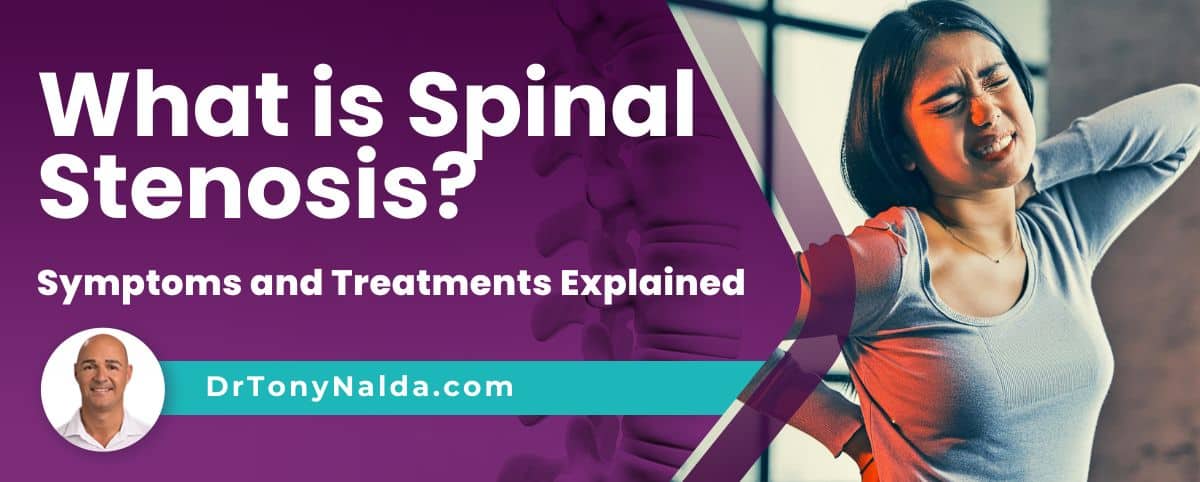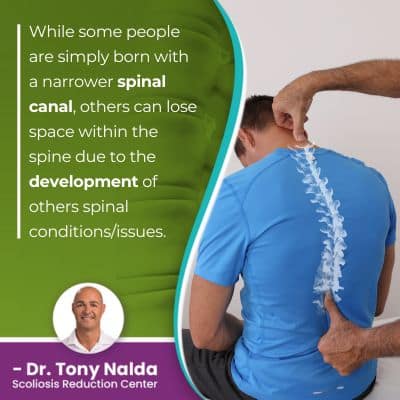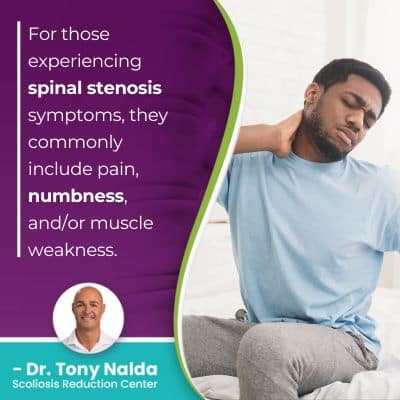What is Spinal Stenosis? Symptoms and Treatments Explained

The spine helps us to stand upright, move flexibly, protects important organs, and works with the brain to form the central nervous system (CNS). When the spine loses space within, it can affect the spinal cord and cause a number of symptoms.
Spinal stenosis is diagnosed when there is a loss of space within the spine, and this can cause the nerves within to become compressed, pinched, and/or impinged; this can affect their function and cause a variety of symptoms.
There are a number of spinal conditions that can impact the spinal nerves within, so let's start with some basic spinal anatomy.
Table of Contents
Anatomy of a Healthy Spine
A healthy spine is naturally curved at each of its main sections; it will appear straight when viewed from the front and/or back, and it will take on a soft 'S' shape when viewed from the sides.
The spine is one long structure that has different sections, and the health of each section depends on the health of the others; if one section loses a healthy spinal curve, for example, the spine can respond by putting in compensatory curves in an attempt to re-balance and align the spine.
The spine consists of vertebrae (bones) stacked on top of one another and separated by an intervertebral disc.
The discs sit between adjacent vertebrae and are essential structures of the spine because of the many roles they play in maintaining spinal health and function.
The discs combine forces to facilitate flexible movement, act as the spine's shock absorbers, give the spine structural support (adjacent discs attach to the disc in between), and they provide cushioning so vertebral bodies don't create friction during movement.
In most cases of spinal degeneration, it's the discs that are the first structures of the spine to deteriorate; degenerative disc disease is a contributing factor in the development of a number of spinal conditions, stenosis included.
The Spinal Cord
The vertebral bodies have a hollow center through which the spinal cord passes, containing 31 pairs of spinal nerves.
The three main sections of the spine include the cervical spine (neck), thoracic spine (middle/upper back), and the lumbar spine (lower back), and each section has unique roles to play in how the spine functions, and what happens to a spinal section can affect the nerves within.
The cervical spine acts as a bridge between the brain and the rest of the body, it has to support the weight of the head, the neck, and facilitate the neck's range of motion; the cervical spine contains the first seven vertebral bodies (C1 to C7).
The thoracic spine is the largest spinal section and is the only section attached to the rib cage, so the thoracic spine helps protect important organs, like the heart and lungs that are protected by the rib cage, and the thoracic spine contains 12 vertebrae (T1 to T12).
The lumbar spine has to support the weight of the trunk, spinal sections above, and its vertebrae feel the effects of bending, twisting, and lifting motions, which is why it's said that everyone will experience a degree of lower back pain throughout their lives.
The cervical spine contains 8 cervical spine nerves; the thoracic spine contains 12 pairs of nerves, and the lumbar spine has 5 pairs of spinal nerves within.
The 31 pairs of spinal nerves that make up the spinal cord are mixed nerves containing both sensory and motor fibers, meaning they are involved in sensory responses and movement, and these nerves work together to share sensory, autonomic, and motor responses/signals between the spinal cord and the rest of the body, where the spinal nerves branch off.
So what happens if a spinal nerve is being squeezed because there is less room within the spine?
What is Spinal Stenosis?
 Nerves don't like to be stretched and squeezed, and when there is uneven pressure on the spinal cord, nerves within can become compressed, pinched, and impinged, and this means there is less room within the spine for the nerves to function optimally within.
Nerves don't like to be stretched and squeezed, and when there is uneven pressure on the spinal cord, nerves within can become compressed, pinched, and impinged, and this means there is less room within the spine for the nerves to function optimally within.
Spinal stenosis is most common in the cervical and lumbar spinal sections as cervical stenosis or lumbar stenosis, and lumbar spinal stenosis is most often diagnosed.
While some people are simply born with a narrower spinal canal, others can lose space within the spine due to the development of other spinal condition's/issues.
Spinal Stenosis Causes
There are a number of causes for spinal stenosis, and while some people don't experience noticeable symptoms of spinal stenosis, others do.
Treatment needs are shared around the underlying cause of the stenosis which can include bone spurs, disc herniation, thickened ligaments, and trauma.
Bone Spurs
Bone spurs are bony overgrowths that tend to form on the edge of bones, or where they meet, in the joints, and these bony projections extend into areas they shouldn't, taking up space and exposing the area to uneven pressure.
Bone spurs can be caused by bone diseases such as osteoporosis and Paget's disease.
Herniated Disk
If a disc becomes herniated, this means its inner nucleus has pushed through the disc's outer annulus, causing the disc material to project into the space surrounding the disc, and this can cause compression of the spinal cord and its nerves within.
Disc herniation can be caused by a disc degenerating, becoming desiccated, and forming cracks, through with the disc's inner material can bulge and then push through to become herniated.
Thickened Ligaments
The vertebrae of the spine are held together by the discs, the spine itself, and thick ligaments that are durable and strong, but if these ligaments get thicker over time, they can become rigid and start to bulge into the spinal canal, causing the development of spinal stenosis.
Anything that takes space from the spinal canal can cause the development of spinal stenosis in an affected spinal section.
Spinal Injury/Trauma
If the spine becomes dislocated or fractured in one or more vertebral bodies, the displaced bone can cause damage to the interior of the spinal canal and its nerves within.
Spinal surgery can also cause tissue to become inflamed and/or irritated, and this inflammation can add excessive pressure to the spinal cord.
Symptoms of Spinal Stenosis
Not all cases of spinal stenosis cause noticeable symptoms; in fact, many patients are diagnosed with spinal stenosis by accident, when they are getting an X-ray done for other reasons.
Symptoms of spinal stenosis tend to get worse over time, particularly in older adults for whom age-related spinal degeneration is an issue.
Spinal stenosis symptoms are shaped by its location within the spine and the degree of nerve involvement; the more nerve roots affected, the more noticeable the effects will be.
Symptoms can involve flare ups during which time symptoms become noticeable, or symptoms that are more chronic and debilitating.
For those experiencing spinal stenosis symptoms, they commonly include pain, numbness, and/or muscle weakness.
Treatment for Spinal Stenosis
 Treatment options for spinal stenosis will depend on a condition's underlying cause.
Treatment options for spinal stenosis will depend on a condition's underlying cause.
Here at the Scoliosis Reduction Center, I've had years of experience treating many types of spinal conditions, stenosis included.
The key to treatment success is determining a condition's underlying cause and customizing a treatment plan around it, and this involves addressing experienced symptoms and the location of the stenosis within the spine.
Conservative Treatment
The goal of conservative treatment is to avoid surgery because spinal surgery is invasive and can lead to other issues.
Through chiropractic care, I can increase the spine's strength, stability, and flexibility. I can apply manual adjustments to address any areas of spinal misalignment so pressure can be taken off the spinal cord, and physical therapy can help relax muscles, ligaments, increase core strength so the spine is optimally supported and stabilized.
No two treatment plans will be the same, and physical therapy can also include alternating hot/cold therapy to relax tight and sore muscles, and this makes them more responsive to treatment, while also offering pain relief and pain management options.
There is also ultrasound-guided electrical nerve stimulation to stimulate nerves, muscles, and massage therapy can also be helpful, particularly with pain relief and muscle relaxation.
Therapeutic exercises/stretches are also important and can help with stabilizing the spine, supporting the spine, improving posture, spinal flexibility, and increasing core strength; all these things help take pressure off the spine, its intervertebral discs, and the nerves within.
When needed, spinal stenosis treatment can also include the prescription of anti-inflammatory medications and injections to help reduce inflammation and pain management.
Conclusion
Spinal stenosis can develop over time as the spinal canal narrows and compresses the spinal nerves within.
The spinal cord and brain work in tandem to form the body's central nervous system (CNS), and the central nervous system is a vast communication network that facilitates brain-body communication.
As mixed nerves, symptoms of spinal nerve compression can involve both sensory and motor responses such as tingling, numbness, electric shock-like pain, and disruptions to mobility and muscle weakness.
Some people with spinal stenosis simply have narrower spinal canals they were born with, but others develop the issue over time, and common causes can include bone spurs, disc herniation, thick ligaments, and spinal injury and/or trauma.
Here at the Center, patients with spinal stenosis benefit from a proactive conservative treatment approach that involves customizing treatment plans around a condition's underlying cause and experienced symptoms.
Dr. Tony Nalda
DOCTOR OF CHIROPRACTIC
After receiving an undergraduate degree in psychology and his Doctorate of Chiropractic from Life University, Dr. Nalda settled in Celebration, Florida and proceeded to build one of Central Florida’s most successful chiropractic clinics.
His experience with patients suffering from scoliosis, and the confusion and frustration they faced, led him to seek a specialty in scoliosis care. In 2006 he completed his Intensive Care Certification from CLEAR Institute, a leading scoliosis educational and certification center.
About Dr. Tony Nalda
 Ready to explore scoliosis treatment? Contact Us Now
Ready to explore scoliosis treatment? Contact Us Now





